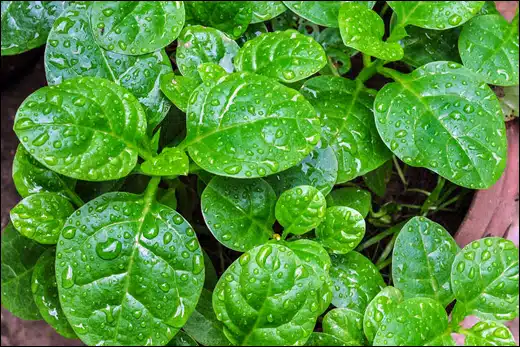Upodika / Malabar spinach / Basella Rubra – Classification, Ayurvedic Properties & Dosage
Description
Malabar spinach (Upodika) is an Ayurvedic herb helpful in the treatment of anemia, cough, dysentery and diarrhea. Also, it shows Anti- diabetic, Anti- cancer, Anti- ulcer, Anti- microbial, Anti-oxidant, Anti- inflammatory, Anti- pruritis properties. In Ayurveda, it is used either alone or in combination for mada (intoxication), anidra (insomnia), paadadari (cracked feet), jvara (fever), pravaahikaa (dysentery), arshas (hemorrhoids), siatapitta (urticaria), varnasotha (inflammatory), arbuda (tumors), raktapitta (bleeding disorders).

Synonyms
- Poi
- Potaki
- Maalvaa
- Amritvallari
- Madaghni
- Vrinthaka
Other Vernacular Names
- In Hindi – poi ka saag
- In English – Indian spinach, Ceylon spinach
- In Malaysia – Bunga siam
- In Gujarati – Ganthalo khar
- In Bengali – Puishaka
- In Konkani – Valchibhaji
- In Marathi – Bhajyacha vel, mayalu
- In Oriya – Poi saga
- In French – Epinard d’lnde Baselle, Epinard Malabar
- In Germany – Malabarspinat
Taxonomical Classification
- Kingdom – Plantae
- Phylum – Trachaeophyta
- Class – Magnoliopsida
- Order – Caryophyllales
- Family – Basellaceae
- Genus – Basella
- Species – Basella rudra (red stem) Basella alba (green stem)
Habitat
Native plant of tropical Africa and Asia, now cultivated as pot herb. A hot, sun-drenched climate is suitable for plant cultivation. Soil with a high organic matter content, moisture and proper drainage system is required for plant growth. Growth is slow in cold regions.
Morphology
It is a heat tolerant, fast growing soft stemmed perennial vine, wildly cultivated as a cool- seasoned vegetable. The plant is a succulent, branched, twinning, and herbaceous vine reaching 10 meter in length. The stems are green (Basella alba) or purplish (Basella Rubra) in color having heart shaped (cordate) leaves with a mucilaginous texture. Fruits are fleshy, red or black, stalk-less, ovoid. Seeds are tiny, numerous, and remain viable up to four years.
Chemical Composition
Irimeda has various phytochemicals due to these compounds, it shows a variety of pharmacognostic activities. These are:
| Phytochemicals | Compound Name | Properties |
| Alkaloids | β cyanine (Anthocyanidins) | Antioxidant, Anti inflammatory |
| Flavonoids | Acecetin, Kaempferol, Rutin | Anti cancer, Anti plasmodial, Inhibits cell proliferation, Anti neuroinflammation |
| Steroids | β- sitasterol, Stigmasterol | Hypercholesterolemia, Anti osteoarthritic |
| Other Bioactive chemicals | β carotene, Ferulic Acid, Lupeol, Syringic Acid, Basellasaponins | Provitamin, Inhibits melanin formation, Lowers Cholesterol level, Anti endotoxin effects, Constipation and anti inflmmatory |
| Vitamins | A, B9,C,E, K | |
| Minerals | Iron, Calcium, Magnesium | |
| Essential amino acid | Arginine, Lysine, Leucine, Isoleucine, Tryptophan, Threonine |
Classical Categorisation
- Bhavaprakash nighantu: Shaka varga
- Kaiyadeva Nighantu: Aushadhi varga
- Raja Nighantu: Mulakadi varga
- Shodala Nighantu: Guduchyadi Varga
Ancient Verse
Shloka – 1
पोतक्युपोदिका सा तु मालवाऽमृतवल्लरी |
पोतकी शीतला स्निग्धा श्लेष्मला वातपित्तनुत् |
अकण्ठ्या पिच्छिला निद्राशुक्रदा रक्तपित्तजित् |
बलदा रुचिकृत्पथ्या बृंहणी तृप्तिकारिणी ||७||
Reference – Bhavprakash Nighantu / Shakvarga / Shloka no. 8-9
Interpretation of Shloka – Potaki is also called Upodika, Maalva and Amritvallari. It is sheeta (cooling potency), snigdha (softness), Increases kapha, decreases vata and pitta. It is not used for throat problems, having mucilagous substance, nidrada (improves sleep), shukarda (increases semen), rakhtapittajith (relieves bleeding disorders), balada (increases strength), ruchikrth (improves taste).
Shloka – 2
उपोदकी कलम्बी च पिच्छिला पिच्छिलच्छदा |
मोहिनी मदशाकश्च विशालाद्या ह्युपोदकी ||१३६||
उपोदकी कषायोष्णा कटुका मधुरा च सा |
निद्राऽऽलस्यकरी रुच्या विष्टम्भश्लेष्मकारिणी ||१३७||
Reference – Raj Nighantu / Mulakadi varga / shloka no.136 -137
Interpretation of Shloka – Upodaki is known as Kalambi and Mohini. It is a sweet herb with astringent and hot potency. It induces sleep and lethargy and improves appetizer and digestive process. It increases kapha and vistambha.
Ayurvedic Properties
In Ayurveda, Upodika is known for its cooling properties helpful in healing skin infections, digestive disorders, and improving sleep. It is also used for the treatment of bleeding problems in women during pregnancy and healing wounds. It is rich in minerals like iron and calcium, helps in anemia and strengthens in bones
Practical Uses / Benefits
There are following uses or benefits of Upodika:
- Decoction of the leaves is a good laxative for pregnant women and children.
- The mucilaginous leaf is administered externally to cure fungal diseases like Eczema, ringworm and general skin infections.
- In traditional medicine, it is used to treat sexual asthenia and infertility in men.
- Flowers are useful for removal of kidney stones, gonorrhea and headache.
- Daily consumption of pureed leafy vegetables has a positive effect on vitamin A stores in populations at risk of vitamin A deficiency.
- Root decoction is given in intestinal disorders.
- Leaves are used for enema followed by manual removal of the hard faeces in ethnoveterinary animals.
- Red dye from the fruit is used for rouge and official seals.
Part Used
Root, Stem, Leaves, Flower, Seed
Dosage
All plant parts are used in many combinations as per requirement.


